
Publisher:
Bonnie King
CONTACT:
Newsroom@Salem-news.com
Advertising:
Adsales@Salem-news.com

~Truth~
~Justice~
~Peace~
TJP
Nov-18-2010 22:18

 TweetFollow @OregonNews
TweetFollow @OregonNews
Of Scorpions, Settlers, Soldiers, and Springs
Dr. Mazin Qumsiyeh Salem-News.comDr. Mazin Qumsiyeh reports on a field visit to an area heavily impacted by the occupation in the Jordan valley
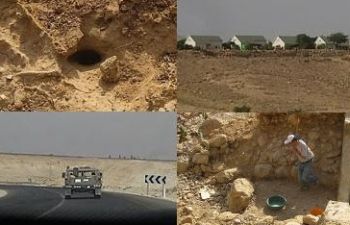 Scorpion nest, Settler homes, Soldiers on the road, and Springs (dry) |
(JERICHO) - We spent two days in the Auja area north of Jericho on a field trip to survey what remains of the animals and plants in one of hundreds of areas directly devastated by Israeli occupation policies.
Our host and guide was Mubarak Zawahra, a father of seven young children who lives near Bethlehem but his mother and many of his brothers live in the Jordan valley.
The family are considered Bedouins. Bedouins are not nomads. Before their lives were restricted and devastated by the occupation they usually held two locations (one for the winter months and one for the summer months).
They relied on their economy on flocks of sheep and goats that they grazed in the wide open areas around the two locations. They also raised pigeons and chickens and occasionally planted crops.
Mubarak's father was so successful at what he did that at one point he and his 16 children had over 1000 head of sheep and goats. It was not an easy life and required very hard work.
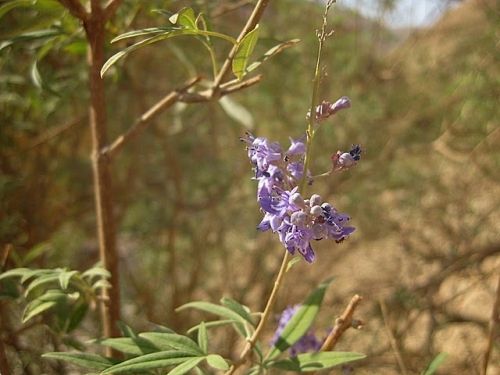 Arabic name of this plant "Ghar" - The leaves have a unique scent and can be |
Their life meant covering many miles every day to reduce overgrazing. Spending over 12 hours daily walking rough terrains, Bedouins come to know every small path, wadi, tree, cave, depression etc. over vast areas. Their encyclopedic knowledge of their surroundings is astounding. They have stories to tell you about every feature of their landscape, every animal and every plant.
Even as a seasoned biologist, I always learn new things from going out with Bedouins about nature. They have unique names even for the different species of desert land snails. They can tell you of natural treatments to different maladies.
While life was difficult, it was a life that functioned in harmony with nature and with spiritual matters for thousands of years. Their generosity and kindness to strangers is legendary. Disputes were mostly solved by tribal traditional laws.
The fields were not overgrazed and nature was left untouched. The balance was maintained and tranquility prevailed and as Mubarak told me in the evening after a very hard day of work in the fields, the best time was to sit after a meal, drink strong sweet tea seasoned with wild mint surrounded by loved ones and look at clear skies dotted with brilliant stars.
That life of course is slowly ending. The Zawahra's saga is just an example. Colonial Jewish settlements in two main locations of the Zawahra's domain (in the hills around Bethlehem and in the Jordan valley) have made it impossible for the Zawahras to continue the Bedouin way of life.
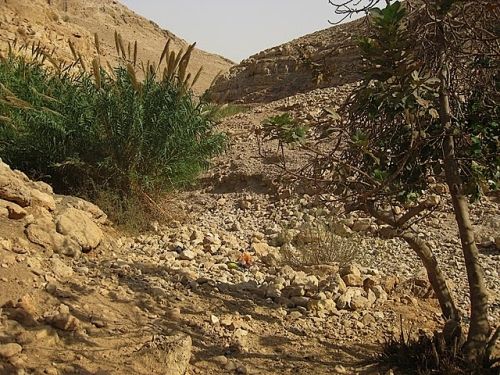 Wadi Auja - here is the path of the spring but it is now dry |
In the Bethlehem district, Israeli colonies, security zones, army bases etc now control the vast majority of the rich lands. The remaining land is basically the developed Palestinian areas with few open areas.
With less than 5% of the open range areas of the Bethlehem district left available for grazing, the impact was devastating: 1) significant decrease in number of animals (even as the human population more than trippled in the past 45 years), and 2) the forced overgrazing on the few remaining open areas had a devastating ecological effect. It is sad to compare biodiversity in the Bethlehem area today versus what I saw 40 years ago.
Many species can no longer be found in the hills of Bethlehem (both plants and animals). Some areas are so barren that the only living animals I can see in the late summer and fall months are humans, goats (more hardy than sheep), and flies. These were areas that 40 years ago, I could show you at least 40 species in a span of 2 hours.
The second domain of the Zawahras is in the Jordan valley a few kilometers north of Jericho in the Wadi Auja area. This valley had until a few years ago water flow year round estimated at 9 million cubic meters coming from the hills near Ramallah and flowing into the Jordan valley to feed the river Jordan.
It made a beautiful oasis that attracted thousands of visitors year round for recreation. Downstream, agriculture has flourished. Farms had been established and the tranquil village of Auja with 7000 residents including Christians and Muslim farmers and Bedouins flourished.
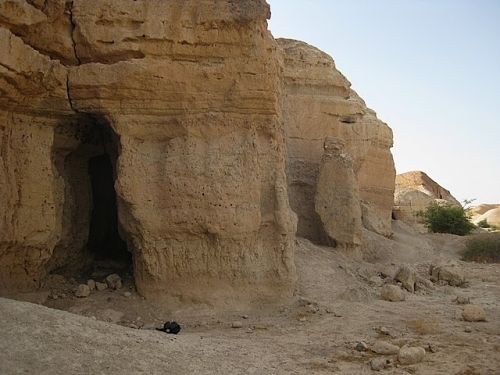 One of the caves at Wadi Auja where we found many free-tailed bats LikeUnlike |
My school mate Imad Mukarkar took me to his family farm there when we were in high school over 35 years ago and I distinctly remember bountiful citrus fruit, bananas, vegetables of all kinds etc. On Tuesday night as we stretched nets to catch bats, we chatted with his brother Khalid who is struggling to maintain the family farm.
He explained how even the well water he relied on is decreasing in output both in quality and quantity while the settlers nearby have unlimited water to grow corn and even watermelons. A way of life is slowly being squeezed for the Palestinians and created for colonial Jewish settlers. These settlers looking for short term political achievements have no clue about the long term consequences of their policies.
Stealing water via pipes at the hills and bringing it to the Jewish settler communities also via closed pipes dried up the natural flow of water in Wadi Auja.
The oasis is no longer an oasis. The valley now has water only in the brief rainy season (for about two months at best) whern up until the late 1990s had water year-round. The crisis of water is so desperate that winter rain runoff will be collected via a dam adding to the changes created by the Israeli water theft.
Desertification (already a problem because of global warming) has thus accelerated. The rich valley fauna and flora was devastated. We did manage to record three species of scorpions, two species of bats, spiny mice, five species of birds, two lizards, a desert fox, and struggling desert trees and shrubs.
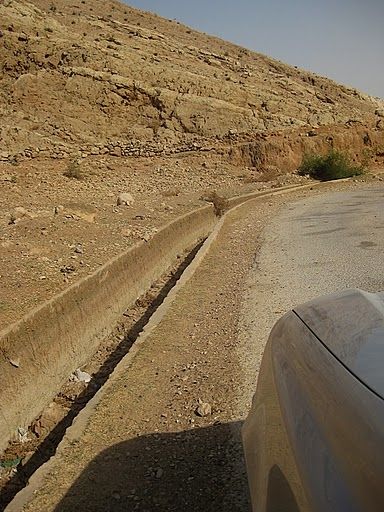 Wadi Auja - here is the path of the water chanel but it is now dry |
We were interrupted once by an Israeli military patrol who wanted to know what we were doing and seemed bemused by our scorpions. One soldier stated that they kill many of them.
I did not want to argue but I did think in my mind that scorpions are really much kinder than some people since they do kill only for food or to defend themselves.
Comparing field work now and three decades ago, we can see dramatic differences. For example I distinctly recall over 20 species of birds seen in one morning and we now found no frogs, an important environmental indicator, when there used to be plenty.
The loss of biodiversity meant a loss of livelihood for the native Palestinians who live in this area. The Zawahra family who had hundreds of sheep and hundreds of goats now have few animals and struggle to find menial jobs to make a living.
And farmers like Khalid Mukarker who used to get plentiful agricultural produce have seen their costs quadruple and their output decline. Local animals and plants lost are irreplaceable.
The quality of water and air deteriorates year after year which will make it eventually impossible even for the colonial settlers to continue to live here. Short term political thinking of Zionists once again trumps long term planning. There is clearly a very heavy economic and ecological cost of colonialism.
Urgent studies and documentation are needed for areas like Al-Auja and increased activism to end this colonial occupation as quickly as possible.
Time is not on our (human) side.
Very soon, the damages done to the environment will make life impossible for all of us (Jews, Christians, Muslims, other animals, and plants) in this (un)holy Land.
Thanks to Mubarak, his family, my wife, my student Michael and his brother Majd for help in making this trip successful.
Here are two pictures of Auja valley with water in it a few years ago
http://www.flickr.com/photos/
http://foeme.files.wordpress.
_verkleind.jpg
and here is a link to pictures posted by my wife from our field trip (slideshow images are from this page)
http://tinyurl.com/2whe5cb
For details on what is happening in Al-Auja including maps, see this report
by the Applied Research Institute - Jerusalem
http://www.poica.org/editor/
Mazin Qumsiyeh, PhD
http://qumsiyeh.org
-------------- next part --------------
An HTML attachment was scrubbed...
URL: <http://lists.qumsiyeh.org/
______________________________
HumanRights newsletter
http://lists.qumsiyeh.org/
This message was sent to newsroom@salem-news.com. To unsubscribe, visit:
http://lists.qumsiyeh.org/
======================================================
 Mazin Qumsiyeh, PhD - Popular Committee to Defend Ush Ghrab (PCDUG) "A Bedouin in Cyberspace, a villager at home. Mazin has been an Associate Professor of Genetics; Director, Cytogenetics Laboratory at Yale University School of Medicine since 1999. He previously held a similar position at Duke University. Professor Qumsiyeh has authored over 110 scientific papers in areas of mammalogy, biology, and medicine including mammalian biology and evolution, clinical genetics, and cancer research. He has published over 100 letters to the editor and 30 op-ed pieces in International, national, regional and local papers on issues ranging from politics to environmental issues. His appearances in national media included the Washington Post, New York Times, Boston Globe, CNBC, C-Span, and ABC, among others. He is the founder and president of the Holy Land Conservation Foundation and ex-President of the Middle East Genetics Association, and Prof. Qumsiyeh won the Jallow activism award from the Arab American Anti-Discrimination Committee in 1998. Those are just a small list, visit Mazin Qumsiyeh's amazing and informative Website to learn more: qumsiyeh.org.
Mazin Qumsiyeh, PhD - Popular Committee to Defend Ush Ghrab (PCDUG) "A Bedouin in Cyberspace, a villager at home. Mazin has been an Associate Professor of Genetics; Director, Cytogenetics Laboratory at Yale University School of Medicine since 1999. He previously held a similar position at Duke University. Professor Qumsiyeh has authored over 110 scientific papers in areas of mammalogy, biology, and medicine including mammalian biology and evolution, clinical genetics, and cancer research. He has published over 100 letters to the editor and 30 op-ed pieces in International, national, regional and local papers on issues ranging from politics to environmental issues. His appearances in national media included the Washington Post, New York Times, Boston Globe, CNBC, C-Span, and ABC, among others. He is the founder and president of the Holy Land Conservation Foundation and ex-President of the Middle East Genetics Association, and Prof. Qumsiyeh won the Jallow activism award from the Arab American Anti-Discrimination Committee in 1998. Those are just a small list, visit Mazin Qumsiyeh's amazing and informative Website to learn more: qumsiyeh.org.
Articles for November 17, 2010 | Articles for November 18, 2010 | Articles for November 19, 2010




Salem-News.com:
Quick Links
DINING
Willamette UniversityGoudy Commons Cafe
Dine on the Queen
Willamette Queen Sternwheeler
MUST SEE SALEM
Oregon Capitol ToursCapitol History Gateway
Willamette River Ride
Willamette Queen Sternwheeler
Historic Home Tours:
Deepwood Museum
The Bush House
Gaiety Hollow Garden
AUCTIONS - APPRAISALS
Auction Masters & AppraisalsCONSTRUCTION SERVICES
Roofing and ContractingSheridan, Ore.
ONLINE SHOPPING
Special Occasion DressesAdvertise with Salem-News
Contact:AdSales@Salem-News.com
Terms of Service | Privacy Policy
All comments and messages are approved by people and self promotional links or unacceptable comments are denied.
[Return to Top]
©2025 Salem-News.com. All opinions expressed in this article are those of the author and do not necessarily reflect those of Salem-News.com.